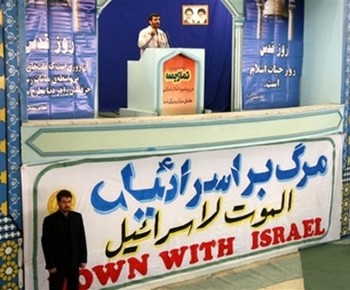Iranian president Mahmoud Ahmadinejad made international headlines when on October 27, 2005, he declared in Persian that Iran would “wipe Israel off the map.” Some commentators in the United States, most notably University of Michigan professor Juan Cole, argued that the phrase was a mistranslation and that Ahmadinejad did not have genocidal intent.[1] But, the Islamic Republic’s official English translation rendered the phrase “Israel must be wiped off the map,”[2] and the regime reiterated its English translation on billboards and murals.[3]
|
President Mahmoud Ahmadinejad lectures above a sign saying “Death to Israel” in Persian and Arabic, not “Down with Israel” as in the English translation below. Ahmadinejad has also declared in Persian that Iran will “wipe Israel off the map.” University of Michigan’s Juan Cole argued that the phrase was a mistranslation and that Ahmadinejad did not have genocidal intent. |
Iranian statements demonizing Jews are not new and, indeed, have long been part of Iranian political and religious culture,[4] but they have acquired new significance in the light of Iran’s pursuit of nuclear enrichment technology, its development of missile delivery systems, and its support of terror proxies. Tel Aviv University professor Meir Litvak has extensively chronicled official Iranian anti-Semitism and Holocaust denial.[5]
Background
It was under the shah that the government began a massive dissemination of the Protocols of the Elders of Zion, the hundred-year old Russian forgery alleging a Jewish plot to take over the world; its publication was subsidized and was made even more widely available after the Islamic Revolution. Excoriation of Jews was a frequent theme in Ayatollah Ruhollah Khomeini’s writings going back to the 1970s. In his famous Hukumat-i Islami (Islamic governance),[6] the 1970 book which laid out the philosophy of clerical rule, Khomeini referred to “wretched Jews” and offered allusions to Islamic history to depict Jews as a source of corruption among Muslims, asking God to curse them.[7] Khomeini declared, for example, that the “Jews … wish to establish Jewish domination … Since they are a cunning and resourceful group of people, I fear that … they may one day achieve their goal,”[8] and that the “Jews have grasped the world with both hands and are devouring it with an insatiable appetite; they are devouring America and have now turned their attention to Iran and still they are not satisfied.”[9]
After the Islamic Revolution, statements calling for the eradication of Israel and hate language using dehumanizing medical metaphors to describe Jews and Israel became commonplace although Khomeini began substituting the word “Zionist” for “Jew.”[10] The Iranian leadership has made such statements more frequently since Ahmadinejad assumed office in 2005. While Khomeini’s image personifies radicalism in the West, it was his successor, Grand Ayatollah Sayyid’Ali Hosayni Khamane’i, who began to dehumanize Israel as a “cancerous tumor,”[11] a term he and his allies have continued to use through the years. However, the frequency and intensity of such anti-Semitic and anti-Zionist statements fluctuates across time. Evidence suggests that Iranian leaders’ genocidal rhetoric declines in frequency as the international community augments pressure. Conversely, when diplomats engage with and relieve pressure on the Islamic Republic, the severity of Iranian oratory increases-a trend present through March 2009.
Rhetoric matters and words kill. The U.N. Convention on the Prevention and Punishment of Genocide and Incitement to Genocide specifies that incitement to genocide is a crime against humanity. [12] Since the Holocaust, genocide scholars have identified hate language and incitement-notably the use of dehumanizing medical metaphors-as predictors, promoters, and catalysts of genocidal agendas in Cambodia, Yugoslavia, Rwanda, and the Sudan. [13] Gregory Gordon, former legal officer of the International Criminal Tribunal for Rwanda, has written that genocide cannot occur without incitement. He has outlined the legal tools available for the international legal community to deal with incitement to genocide and spelled out five questions relevant to defining such incitement: “Where was the statement made? Is it sufficiently public? Is it sufficiently direct? Is it permissible free speech or criminal incitement? What is the state of mind of the person uttering the statements-is there intent to incite?” Gordon notes that, given the precedents in international law, “causation is not an element,” and that even if incitement does not result in genocide, the person who incites may still be guilty of incitement to genocide-a principle applicable to the repeated statements by Khamane’i, Ahmadinejad, and other Iranian officials.[14]
While Cole and the National Iranian American Council-the Islamic Republic’s de facto lobby in Washington-play down Iranian rhetoric and deny any incitement to genocide, a number of scholars, most prominently Tel Aviv University scholar Joshua Teitelbaum, editor-designate of the Middle East Quarterly Denis MacEoin, and German political scientist Matthias Küntzel, have chronicled Iranian rhetoric, including its dehumanizing medical metaphors recalling those used by Nazi propagandists since Adolf Hitler wrote Mein Kampf.[15]
Table 1 compiles statements by members of the Iranian political hierarchy and clerical leaders going back to 2000. Public statements appear to have increased in frequency from February 2008 and generally conform to Khomeini’s substitution of Zionists for Jews although there have been exceptions. On April 14, 2005, for example, Grand Ayatollah Hosein Nuri-Hamadani, one of Shi’ism’s top twenty-three authorities, declared, “One should fight the Jews and vanquish them so that the conditions for the advent of the Hidden Imam are met.”[16] Nuri-Hamadani is also noted for his extreme views on women, secularism, liberalism, and Islamic mysticism.
Table 1: Timeline of Statements by Ahmadinejad and other Iranian leaders (2000-2008)
| Date | Person | Statement and Actions |
| Dec. 15, 2000 | Khamane’i | Iran’s position, first expressed by the imam, and stated several times by those responsible, is that the cancerous tumor called Israel must be uprooted from the region |
| Jan. 15, 2001 | Khamane’i | “the perpetual subject of Iran is the elimination of Israel from the region” translated by journalist Kasra Naji: “mission of IRI is to erase Israel from the map of the region.” |
| Dec. 14, 2001 | Rafsanjani | “If one day … the Islamic world will be equipped with weapons available to Israel now … the employment of even one atomic bomb inside Israel will wipe it off the face of the earth but would only do damage to the Islamic world.” |
| Sept. 22, 2003 | Banner on Shihab 3 missile (photo) | “Israel must be uprooted and wiped from history.” |
| Oct. 2005 | Iranian regime | Iranian publishers display English edition of Protocols of Zion at a Frankfurt book fair |
| Apr. 2005 | Ayatollah Nouri-Hamedani | “One should fight the Jews and vanquish them so that the conditions for the advent of the Hidden Imam will be met.” |
| Oct. 26, 2005 | Ahmadinejad | “Our dear Imam [Khomeini] ordered that this Jerusalem occupying regime must be erased from the page of time. This was a very wise statement.” “Soon this stain of disgrace will be cleaned from the garment of the world of Islam, and this is attainable.” |
| Oct. 27, 2005 | Ahmadinejad | “Anybody who recognizes Israel will burn in the fire of the Islamic nation’s fury.” Any Islamic leader “who recognizes the Zionist regime means he is acknowledging the surrender and defeat of the Islamic world.” |
| Oct. 30, 2005 | Hossein Shariatmadari | “We will be satisfied with nothing less than the complete obliteration of the Zionist regime from the political map of the world.” |
| Apr. 14, 2006 | Ahmadinejad | “Israel heading towards annihilation.” “a dried, rotten tree that will collapse with a single storm.” |
| June 9, 2006 | Mohammad Ali Ramin | “Among the Jews, there have always been those who killed God’s prophets…. it was said that they were the source for such deadly diseases as the plague and typhus. This is because the Jews are very filthy people. For a time, people also said that they poisoned water wells belonging to the Christians and thus killed them.” |
| Oct. 22, 2006 | Resalat (Tehran) | “Great war is ahead of us, perhaps tomorrow, or in a few months, or even a few years. The nation of Muslims must prepare for the great war, so as to completely wipe out the Zionist dream, and remove this cancerous growth.” |
| Nov. 2006 | Banner on bus at military rally | “Israel should be wiped off the face of the world!” |
| Dec. 2006 | Ahmadinejad | “the Zionist regime will be wiped out, and humanity will be liberated” – freed, that is, from the “acquisitive and invasive” minority. |
| Sept. 2007 | Ahmadinejad | “brutal Zionists” “Zionist regime” “Palestine and Iraq will be liberated from the domination of the occupiers, and the people of America and Europe will be free of the pressure exerted by the Zionists.” |
| Oct. 4, 2007 | Shariatmadari | “Death to America and death to Israel are not only words written on paper, but … a symbolic approach that reflects the desire of all the Muslim nations.” |
| Feb. 5, 2008 | Ahmadinejad | “A people falsified, invented. [Israel] will not last, they must leave the territory.” |
| Feb. 12, 2008 | Ahmad Jannati | “[We have] bigger crowds, slogans more enthusiastic, ‘Islamic Republic of Iran’ regime getting better and better.” “The blind enemies should see that the wish of these people is the death and destruction of America and Israel.” |
| Feb. 18, 2008 | Mohammad Ali Jaafari | “In the near future, we will witness the destruction of the cancerous microbe Israel by the strong and capable hands of … Hezbollah.” |
| Feb. 18, 2008 | Manoucher Mottaki | “even after 60 years, the Zionist regime has neither gained any legitimacy nor played any role in this region.” |
| Feb. 23, 2008 | Yahya Rahim Safavi | “with God’s help, the time has come for the Zionist’s regime death sentence. … the death of this unclean regime will arrive soon following the revolt of the Muslims.” |
| Feb. 23, 2008 | Haddad Adel | “The countdown has begun for the destruction of the Zionist regime.” |
| Feb. 20, 2008 | Ahmadinejad | “they [the global powers] have created a black and filthy microbe called the Zionist regime.” |
| Mar. 14, 2008 | Ahmadinejad | “the Zionist regime is on its way out [destructible].” |
| Apr. 17, 2008 | Ahmadinejad | “The region and the world are prepared for great changes and for being cleansed of Satanic enemies” [referring to the Great Satan (USA) and Little Satan (Israel)] |
| May 13, 2008 | Ahmadinejad | “global arrogance established the Zionist regime.” “[which is] a stinking corpse” |
| May 13, 2008 | Mohammad-Reza Khabbaz, member of the central committee of National Trust reformist party | “Creation of Israel only served the purpose of creating a cancerous tumor in the body of Islamic society.” |
| June 13, 2008 | Ahmadinejad | “terrorist and criminal state … backed by foreign powers … regime to be swept away by Palestinians.” |
| June 14, 2008 | Ahmadinejad | “Israel’s days are numbered … peoples of region know there is the narrowest opportunity to annihilate this false regime.” |
| July 2, 2008 | Ahmadinejad | “Thanks to God, your wish will soon be realized, and this germ of corruption will be wiped off the face of the world.” |
| July 24, 2008 | Esfandiar Rahim Masha’i | “Israel is a cancerous tumor.” “Israel will soon disappear.” |
| Sept. 23, 2008 | Ahmadinejad | “The Zionists are the eternal enemy of ‘the dignity, integrity, and rights of the American and European people.” “Although they are few in number, the Zionists have been dominating an important portion of the financial and monetary centers as well as the political decision-making centers of some European countries and the United States in a deceitful, complex and furtive manner.” “Even some presidential or premier nominees in some big countries have to visit these people, take part in their gatherings, swear allegiance and commitment to their interests in order to attain financial or media support.” Even “the great people of America and various nations of Europe” are caught in the clutches of Jewish power. They “need to obey the demands and wishes of a small number of acquisitive and invasive people. These nations are spending their dignity and resources on the crimes and occupations and the threats of the Zionist network against their will.” “Today … the Zionist regime is on a definite slope to collapse. There is no way for it to get out of the cesspool created by itself and its supporters.” |
| Sept. 25, 2008 | Ahmadinejad | “Zionism … is the root cause of insecurity and wars. … What commitment forces the U.S. government to victimize itself in support of a regime that is basically a criminal one?” |
| Nov. 26, 2008 | Ahmadinejad | “Iran will support Hamas until the destruction of Israel.” |
| Dec. 25, 2008 | Ahmadinejad | “If Christ was on Earth today, undoubtedly he would hoist the banner of justice and love for humanity to oppose warmongers, occupiers, terrorists, and bullies the world over.” [Iran hangs nine individuals before 12/24/08 bringing the yearly total to 244.] |
| Dec. 30, 2008 | Ahmadinejad | “the real Holocaust is now taking place in Gaza Strip and Palestine.” |
| Source: Genocide Prevention Now World Situation Room of the Institute on the Holocaust and Genocide, Jerusalem, and Genocide Prevention Program of the Hebrew University-Hadassah School of Public Health and Community Medicine. Published with the permission of Genocide Prevention Now website. An expanded version of this paper and timeline will be posted on the Genocide Prevention Now website. | ||
Based on available citations, Iranian hate language and incitement against Israel has varied in frequency and intensity across time. Between the September 11, 2001 attacks and the U.S. invasion of Iraq in March 2003, incitement decreased. This was at the height of Iranian president Mohammad Khatami’s so-called “dialogue among civilizations.” Khatami was widely feted as a reformer interested in rapprochement, and it was in this guise that the West embraced him. When his presidency came to an end, both Harvard University and the National Cathedral in Washington invited him to deliver high-profile speeches,[17] and St. Andrews University in Scotland sought to bestow an honorary degree on him; here, however, protestors outraged by his weak endorsement of human rights forced the university to downgrade the award to one not related to human rights.[18] The protestors were not wrong. Khatami’s own staff acknowledged his insincerity. “We had one overt policy, which was one of negotiation and confidence building, and a covert policy, which was continuation of the activities,” the president’s former spokesman, ‘Abd Allah Ramadan-Zada, acknowledged during a June 2008 speech at the University of Gilan.[19]
President Ahmadinejad
On June 24, 2005, Ahmadinejad was elected president. The mayor of Tehran for only two years, he was a virtual unknown in the West. Many Western officials hoped that he would continue the rhetorical trend initiated by Khatami and the so-called reformists and, indeed, Ahmadinejad’s spokesman promised he would do just that.[20]
It was not to be. On October 26, 2005, Ahmadinejad declared, “As the Imam said, the Jerusalem-occupying regime must be erased from the pages of time.”[21] He followed shortly after with “this stain of disgrace will be cleaned from the garment of the world of Islam, and this is attainable.”[22] Such statements were met with outrage from world leaders, most vocally German chancellor Angela Merkel.[23]
There were six inflammatory statements reported in 2006 although there was a pause in the incitement when, at the end of the year, the U.N. Security Council unanimously passed the first of three resolutions sanctioning the Islamic Republic for its nuclear activities, [24] and, in 2007, when the U.S. House of Representatives voted 411 to 2 for House Resolution 21, “Calling on the United Nations Security Council to charge Iranian leader Mahmoud Ahmadinejad with violating the 1948 Convention on the Prevention and Punishment of the Crime of Genocide and United Nations Charter because of his calls for the destruction of the State of Israel.” [25]
Genocide scholars have noted that architects and perpetrators of mass murder are often sensitive to outside public opinion and conceal, camouflage, or calibrate their agendas.[26] This may explain why the frequency and intensity of the hate language and incitement abated after the U.N. Security Council resolutions, even if the personalities holding office in the Iranian government remained constant.
Iranian incitement increased after the U.S. National Intelligence Council released its November 2007 National Intelligence Estimate, which concluded that Tehran had ceased its pursuit of a nuclear weapon in the spring of 2003 when the United States invaded Iraq-an association missed by the council. The release of the estimate relieved diplomatic pressure on the Islamic Republic, whose senior leaders had previously believed there was some possibility that the Bush administration might order military strikes against it.[27] Thereafter, throughout 2008, the Iranian media quoted not only Ahmadinejad but also Khamane’i and a range of other senior officials including Kayhan editor Hossein Shariatmadari, Council of Guardians chairman Ahmad Jannati, Islamic Revolutionary Guard Corps chief Mohammad Ali Jaafari, and Gholam Ali Haddad Adel, a senior expediency council official, making inflammatory statements containing dehumanizing medical metaphors. (See Table 1.)
During the same period, Western universities and media began to book Ahmadinejad as a guest or host him for speeches coinciding with his annual visits to the opening annual sessions of the U.N. General Assembly, thereby bestowing the legitimacy of statesmanship upon him. The Council on Foreign Relations, for example, invited Ahmadinejad to a meeting on September 20, 2006, and Columbia University hosted a speech by Ahmadinejad in September 2007. During his September 2008 trip to the United States, both The New York Times and CNN’s Larry King interviewed him, and various religious figures-including the leadership of the American Friends Service Committee, the leading Quaker nongovernmental organization, dined with him. Three months later, Britain’s television Channel 4 invited Ahmadinejad to deliver its annual alternative Christmas address,[28] a broadcast that, with some irony, occurred concurrently with Iranian police raids on the BBC Persian offices in Iran. [29] True to the pattern, as international isolation continued to ease, incitement using the medical metaphors of hate language returned. Hassan Rowhani, Supreme Leader Khamane’i’s representative on the Supreme National Security Council, referred to Israel as a “cancerous tumor” on January 12, 2009.[30] Soon after President Barack Obama called for a renewal of U.S. engagement with Iran, Khamane’i again referred to Israel as a “cancerous tumor.”[31]
The record suggests that a mixture of increased complacency, acquiescence, and tolerance for ever harsher Iranian hate language, at times with a subtext of legitimization, may have removed the inhibitions to the increasing use of such language, provided it is interspersed occasionally with more circumspect language, such as in Ahmadinejad’s U.K. Christmas Channel 4 oration.
Conclusion
Thirty years have passed since the inauguration of the Islamic Republic. Senior members of the Iranian leadership, first under Khomeini and now under Khamane’i and Ahmadinejad, have successfully transmitted incitement and hate language across generations. The reach of this message is now prolonged, far-reaching, and deep-in part because such messages play on preexisting anti-Semitic motifs already embedded in Middle Eastern and Islamic political culture.[32]
Iranian official rhetoric may serve two purposes. First, it may provide a window into regime thinking: Public hate language and incitement from the senior Iranian leadership signal genocidal intent to destroy Israel, an accomplishment that would deter anyone in the Islamic world from resisting Tehran in the future. Second, with their economy sinking,[33] Iranian leaders may believe that demonizing internal and external enemies could be a useful diversionary tactic.
Whatever the case, the Iranian leadership appears to calibrate the output and intensity of its incitement to the intensity of world reactions. If there is to be any engagement with the Iranian leadership, it must include specific demands for the cessation of incitement to genocide. Such engagement should occur concurrently with the application of the existing tools of international law such as prosecuting individual Iranian leaders for incitement to genocide, or referring the Islamic Republic to the International Court of Justice. Without such tangible measures, Iran’s leaders may believe they have a free hand to implement a genocidal agenda.
Elihu D. Richter heads the Genocide Prevention Program at Hebrew University-Hadassah School of Public Health and Community Medicine and is associate director, Institute on the Holocaust and Genocide. Alex Barnea is research assistant and project manager of the World Genocide Situation Room.
[1] The New York Times, June 11, 2006
[2] Islamic Republic of Iran Broadcasting (Tehran), Oct. 27, 2005.
[3] Agence France-Presse, Mar. 9, 2008; Reuters, Mar. 9, 2008.
[4] For nineteenth century instances, see Daniel Tsadik, Between Foreigners and Shi’is (Stanford: Stanford University Press, 2007).
[5] Meir Litvak and Ester Webman, From Empathy to Denial: Arab Responses to the Holocaust (New York: Columbia University Press, 2009).
[6] The book was published under three different titles, the other two being Vilayat-e Faqih and Nama’i az Imam Musawi Kashef al-Ghita’.
[7] Ayatollah Ruhollah Khomeini, Islam and Revolution: Writings and Declarations of Imam Khomeini, Hamid Algar, ed. and trans. (Los Angeles: Mizan Press, 1981), pp. 47, 89, 127.
[8] Matthias Küntzel, “Iran’s Obsession with the Jews ,”The Weekly Standard, Feb. 19, 2007.
[9] Ibid.
[10] Ibid.
[11] Joshua Teitelbaum, “What Iranian Leaders Really Say about Doing away with Israel,” Jerusalem Center for Public Affairs, July 1, 2008.
[12] Irwin Cotler, “Incitement to Genocide: Record of the Past and Challenges for the Future ,” presentation, “State-Sanctioned Incitement to Genocide: What Can Be Done?” Washington, D.C., Sept. 23, 2008.
[14] See Gregory Gordon, “Incitement to Genocide in International Diplomacy and Law ,” presentation, “State-Sanctioned Incitement to Genocide: What Can Be Done”; idem, “From Incitement to Indictment? Prosecuting Iran’s President for Advocating Israel’s Destruction and Piecing Together Incitement Law’s Emerging Analytical Framework,” The Journal of Criminal Law and Criminology, Spring 2008.
[15] Teitelbaum, “What Iranian Leaders Really Say “; Küntzel, “Iran’s Obsession with the Jews.”
[16] Küntzel, “Iran’s Obsession with the Jews “; Matthias Kuntzel, “Defining Jew-Hatred Down: The Curious Response to Ahmadinejad at the U.N.,” The Weekly Standard, Nov. 17, 2008.
[17] BBC News, Sept. 14 2006
[18] BBC News, Oct. 31, 2006.
[19] Fars News (Tehran), June 14, 2008.
[20] Islamic Republic News Agency (Tehran), June 26, 2005.
[21] Teitelbaum, “What Iranian Leaders Really Say .”
[23] Tagesschau (Hamburg), Dec. 15, 2005.
[24] U.N. Security Council resolutions 1737 (2006), 1747 (2007), 1803 (2008).
[25] House Congressional Resolution 21, June 20, 2007.
[26] Gordon, “From Incitement to Indictment? ”
[27] Sobh-e Sadegh (Tehran), May 3, 2008.
[28] “Mahmoud Ahmadinejad’s Alternative Christmas Message,” Channel 4, Dec. 25, 2008.
[29] Abrar (Tehran), Dec. 25, 2008.
[30] Aghasazi.com (Tehran), Jan. 12, 2009.
[31] The Jerusalem Post, Mar. 4, 2009.
[32] Bernard Lewis, “Muslim Anti-Semitism,” Middle East Quarterly, June 1998, pp. 43-9.
[33] Michael Rubin, “Iran’s Economy Runs out of Steam ,” Forbes.com, Oct. 17, 2008.





